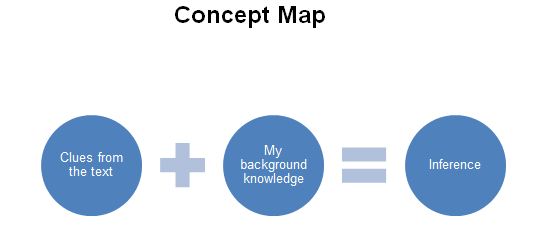Summarizing and Inferencing Content Module
BACK TO Content Modules
Contents |
Plot the Course
The rationale
Whether reading a story, a content area text book, a comic, or a poem, the ability to summarize a text and infer to read between the lines is a lifelong skill readers use to foster higher level thinking and deeper comprehension.
Module Goal
The goal of this module is to provide detailed information on summarizing and inferencing to teachers of students with disabilities at the elementary and middle school level. This module aims to provide teachers with a general overview of these concepts as well as teaching suggestions so that a teacher can begin to plan instruction for these concepts. Additionally, this module provides instructors with potential adaptations and modifications to consider when designing materials and instruction for students with severe disabilities.
Module Objectives
After viewing the content module, teachers will:
- Develop a deeper understanding of summarizing and inferencing as proficient reader strategies.
- Learn instructional strategies for teaching students how to summarize and make inferences when reading to enhance comprehension.
This module is organized using the following sections: Time for Take Off, Floating on Air, and Prepare for Landing. Key vocabulary are provided in the "Time for Take Off" section of the module. Connections to the Common Core State Standards and PowerPoint presentations containing information and instructional suggestions for teaching about summarizing and making inferences are shared in the "Floating on Air" component. In "Prepare for Landing", strategies to review, reinforce, and apply summarizing and making inferences to real world connections are provided.
Time for Take Off
Understanding the vocabulary used when teaching summarizing and inferencing is important for both teachers and students in planning and implementing reading lessons. As a teacher, knowing and using the terms not only ensures your instruction stays true to the content, but will also help with collaborating with other reading teachers or literacy experts. When choosing which vocabulary to teach, it is most important that the teacher selects the most salient, important, or most frequently used vocabulary for each lesson. Below you will find a list of vocabulary related to this module. It may or may not be necessary to provide instruction for all terms as students may have learned them previously. If you are a secondary teacher and are not confident your students have been taught these vocabulary terms, you may want to review and teach those unknown terms during the focus and review section of your lesson plan. While providing vocabulary instruction, you may consider including pictures or objects to make the instruction more concrete for students with disabilities (See Ideas to support vocabulary learning below).
Vocabulary
- summary - containing the key points or big idea
- main idea - the most important idea in the text
- details - specific smaller elements that are part of a larger work
- key word - essential or significant words related to the text
- relevant - has significant importance
- irrelevant - not important or related
- characters - person/persons in a story
- setting - place where the story happens
- plot - sequence of events involving characters in conflict situations
- point of view - perspective from which the story is told
- theme - moral or big idea of the story
- inference - a conclusion or opinion that is formed based on facts or evidence
- context clues - words and sentences within a text that provide additional information
Idea to support vocabulary learning
Use visual representations or actions to explain summarizing and inferencing and their terms. For example, the following images may be shared to teach the word 'inference'.
"An inference I can make from the picture is that the boy is sad." "I am inferring that the boy is excited." "I can infer that it is winter and it is cold."
Floating on Air
Before you can begin teaching your students about summarizing and inferencing, it is important that you first have a deep understanding of the information. Some of the concepts may be familiar to you. Below is a list containing Standard R.L.1 and R.I.1 from the Common Core State Standards for grades K-8. You will also find a series of PowerPoint presentations containing information, examples, and instructional suggestions for both summarizing and inferencing below the chart.
ELA Common Core State Standard 1: Summarizing and Inferencing - Grades K-8
| K | RL.K.1./ RI.K.1. With prompting and support, ask and answer questions about key details in a text. |
| 1 | RL.1. 1. / RI.1.1. Ask and answer questions about key details in a text. |
| 2 | RL.2.1. / RI.2.1. Ask and answer such questions as who, what, where, when, why, and how to demonstrate understanding of key details in a text. |
| 3 | RL.3.1. / RI.3.1. Ask and answer questions to demonstrate understanding of a text, referring explicitly to the text as the basis for the answers. |
| 4 | RL.4.1. / RI.4.1. Refer to details and examples in a text when explaining what the text says explicitly and when drawing inferences from the text. |
| 5 | RL.5.1. / RI.5.1. Quote accurately from a text when explaining what the text says explicitly and when drawing inferences from the text. |
| 6 | RL.6.1. / RI.6.1. Cite textual evidence to support analysis of what the text says explicitly as well as inferences drawn from the text. |
| 7 | RL.7.1. / RI.7.1. Cite several pieces of textual evidence to support analysis of what the text says explicitly as well as inferences drawn from the text. |
| 8 | RL.8.1. / RI.8.1. Cite the textual evidence that most strongly supports an analysis of what the text says explicitly as well as inferences drawn from the text. |
Deepen your understanding. Click on each PowerPoint below.
Great! Now that you have viewed the PowerPoint presentations, the next section will provide some ideas to consider when planning for Universal Design for Learning.
Sharing the Sky
UNIVERSAL DESIGN FOR LEARNING
| Visual Impairment or Deaf/Blind | Physical Impairment:
Little/ No Hand Use |
Lacks Basic Concepts | Motivational/ Attention Issues | |
| Representation | Use a talking device such as an avatar; use large print text, raised text or Braille, use objects and images to represent their summaries or inferences (i.e., character action/feelings, setting); use online tools to create graphic organizers (i.e., Readwritethink.org); Use picture cards and graphic organizers to sort key aspects of the text including key words (i.e., character, setting, etc.). | Student scans an array of possible options and uses a switch to select the correct answer when asked a question pertaining to a given text; use computer representation of key aspects of the text that can be manipulated with switch; place key aspects of the text on a slant board or eye gaze board; create an exercise in the classroom that the student can walk or ride in wheelchair to summarize events in the text. | Use appropriate and accessible text. Rewrite text to simplify plot and details. Include additional images and illustrations to help convey the meaning of the text. Provide students with graphic organizers and sentence starters. Highlight key words within the context of the print. | Use motivating objects and topics to summarize (i.e., puppets or student's favorite character, animal, etc.). Incorporate technology including computer representations, videos, animations, and talking avatar. Allow students to self-select text of interest. |
| Expression | Student states answer; use voice output devices for student to select the correct answer; teach tangible symbols for key phrases (i.e., characters' feelings/actions, setting, predictions, etc.) | Uses a switch to indicate correct answers; uses an eye gaze board to select answer; uses a blink response to select answer; phrase questions so that they require a "yes/no" response, these can easily be answered using an eye gaze, head turn, two switches, etc. | Student selects pre-made cards with key ideas from the text versus writing them; selection of correct answer is done after a model; student answers "yes/no" questions. | Have students summarize text and make inferences with images, drawing, interactive computer programs, etc. |
| Engagement | Teach students to use their hands to scan objects; use talking avatars or read aloud of text; start with simple, use large print text and online interactive text; use text featuring items that are familiar and reinforcing to students. | Use bright colors to call attention to key words; use a computer with AT where the student can click to answer; use cards that are large enough to accommodate the movements that the student is able to make; pair student with another student without a physical impairment and have them work together to summarize the text. | Student uses websites and listening centers that read aloud text. Use bright colored stickers or sticky notes to mark key words within text. Use puppets, objects, and picture cards (i.e., with emotions and actions) to summarize text and make inferences. Explicitly model using think alouds along with visual images and actions. | Create games in which students interact with partners to summarize text and make inferences (i.e., cards with images of actions and character feelings).
Create stories and text that involve the students and their personal interests and experiences. |
Prepare for Landing
Below you will find ideas for linking summaries and inferences to real-world applications, the college and career readiness skills addressed by teaching these concepts, module assessments for teachers, sample general education lesson plans incorporating Universal Design for Learning framework, blog for teachers to share their ideas, and a place to upload and share lesson plans from teachers who completed this module. One way to help assist in a special educator's development within this curricular area is through collaboration with other teachers in your building. Often these skills are practiced outside of an ELA classroom in other curricular areas as well as during everyday tasks. Some activities with real world connection include:
- Associate the skills of summarizing and inferencing to wide range of reading and real world texts. This allows the students to apply the learning to real reading experiences. This supports students' meaning making process and will increase their reading comprehension.
- Students can also practice summarizing skills when discussing TV shows, movies, video games, sports, etc.
- Making inferences is something we do on a daily basis whether we are determining how to dress appropriately for the weather, whether or not an umbrella is needed based on the weather report or the look of the sky, judging someone's mood or feelings based on their reactions and emotions, etc.
In addition to the real-world applications of these concepts, skills taught within this content module also promote the following college and career readiness skills.
Communicative competence
Students will increase their vocabulary to include concepts related to "summarizing" and "inferencing." Specifically, they will learn to use language such as, "I am thinking…" "This text is mostly about…" and "I can infer…"
Fluency in reading, writing, and math
Students will have opportunities to increase their fluency and comprehension as they develop their abilities to summarize and make inferences. By having stronger proficiency with summarizing and inferencing, students will be able to process text more strategically and at a more fluent pace. They will also understand the text in greater depth.
Age appropriate social skills: Students will engage in peer groups to summarize and make inferences within a range of texts.
Independent work behaviors: Students will engage in independent reading. They will have increased opportunities to practice summarizing and making inferences in the real-life reading context.
Skills in accessing support systems: At times, students will need to ask for assistance to complete activities related to "summarizing" and "inferencing" which will give them practice in accessing supports. Students will gain practice asking for help with reading a range of diverse texts as needed. They can ask a peer to complete the physical movements of the tasks they are not able to do themselves. Be sure to teach students to ask versus having items or supports automatically given to them.
In addition to collaborating with other educational professionals in your building, the following list of resources may also help provide special educators with ideas for activities or support a more thorough understanding of the concepts presented in this content module.
Additional Resources
http://www.learner.org/workshops/teachreading35/classrooms/cv8.html – This video features a 5th grade teacher demonstrating how she teaches her students to summarize important information from nonfiction text. Teacher and students discuss what it means to summarize, the purpose, and where to find key information needed to summarize.
http://www.readingrockets.org/podcasts/comprehension/ – This collection of podcasts shows how to teach comprehension strategies. [www.thereadinglady.com-http://www.thereadinglady.com/] – Website provides a wide range of reading comprehension and writing lessons based on the books, Strategies that Work and Mosaic of Thought.
http://www.readinglady.com/mosaic/tools/Inferences handout by Deb Smith.pdf – Handout provides an overview of drawing inferences and comprehension instruction based on the chapters in Reading with Meaning, Mosaic of Thought, and Strategies that Work.
http://www.readingrockets.org/strategies/inference/ –This article highlights how to teach inference in different content areas and provides examples of children's books to use as models for teaching inferencing.
Harvey, S., & Goudvis, A. (2007). Strategies that work: Teaching comprehension for understanding and engagement (2nd ed.). Portland, Me: Stenhouse. – Authors show how to use anchor charts for introducing strategies. Chapter eleven provides quality lessons on summarizing and synthesizing information and chapter nine focuses on inferring and visualizing.
Keene, E., & Zimmerman, S. (2007). Mosaic of thought: Teaching comprehension in a reader's workshop (2nd ed.). Portsmouth, NH: Heinemann. – This book focuses on strategy-based comprehension instruction. Chapter six focuses on teaching inferences.
Miller, D. (2012). Reading with meaning (2nd ed.). Portland, ME: Stenhouse. – This book provides teachers with ideas for strategy instruction throughout the school year with the gradual release model and illustrates how to use current picture books to teach comprehension lessons.
References
Beers, Kylene. (2003). When kids can't read: What teachers can do. Portsmouth, NH: Heinemann.
Gregory, A.E., & Cahill, M. (2010, March). Kindergartners can do it, too! Comprehension strategies for early readers. The Reading Teacher, 63(6), 515-520.
Harvey, Stephanie, & Goudvis, Anne. (2000). Strategies that work (pp. 277-281). York, ME: Stenhouse.
Marzono, R. (2010). Teaching inference. Educational Leadership, 67(7), 80-01. Available online at http://www.ascd.org/publications/educational-leadership/apr10/vol67/num07/Teaching-Inference.aspx.
Module Assessments
Below are links to assessments for the purpose of self-checking your understanding of the content in this module. After answering the assessment questions, you may want to review the key to check your work.
Summarizing and Inferencing Assessment
Summarizing and Inferencing Assessment Key
Sample General Education lesson plans
http://www.readwritethink.org/classroom-resources/lesson-plans/gist-summarizing-strategy-content-290.html?tab=4 – This lesson illustrates how to use the GIST strategy to summarize information through reading website articles and using an online GIST template.
http://www.readwritethink.org/classroom-resources/lesson-plans/book-report-alternative-examining-236.html?tab=4 – This lesson uses the concept of mapping to help students respond to and summarize the text. The teacher models strategies using picture books and students create interactive comic strips.
http://teachingstarstudents.blogspot.com/2012/10/inferencing-lessons-5th-grade.html – This teacher provides ideas and examples of how she included podcasts, video, and hands-on activities to teach her 5th graders how to make inferences.
http://www.readinglady.com/index.php?module=pagemaster&PAGE_user_op=view_page&PAGE_id=6 – This lesson introduces how good readers make inferences. Teacher uses a two-column chart and a picture book to demonstrate how to make inferences from the book title, illustrations, and story.
http://www.readwritethink.org – This lesson designed for 3rd through 5th graders focuses on making inferences working with the genre of biographies.
http://www.tips-for-teachers.com/inferencing_mini_lessons.htm – These lessons were developed based on the books, Reading with Meaning by D. Miller and Strategies that Work by S. Harvey and A. Goudvis. Teacher provides mini lessons, read-alouds, and hands-on activities for teaching inferences.
Adapt the following general education lesson plan; adapt, and upload. These lesson plans may be shared with higher education professionals developing strategies to provide meaningful academic instruction in ELA to students with severe disabilities.







